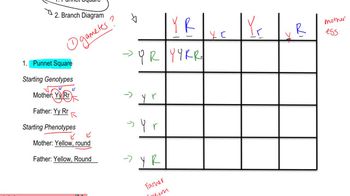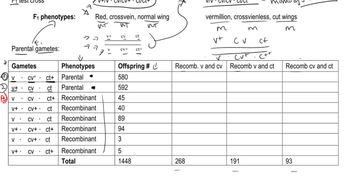Table of contents
- 1. Introduction to Genetics51m
- 2. Mendel's Laws of Inheritance3h 37m
- 3. Extensions to Mendelian Inheritance2h 41m
- 4. Genetic Mapping and Linkage2h 28m
- 5. Genetics of Bacteria and Viruses1h 21m
- 6. Chromosomal Variation1h 48m
- 7. DNA and Chromosome Structure56m
- 8. DNA Replication1h 10m
- 9. Mitosis and Meiosis1h 34m
- 10. Transcription1h 0m
- 11. Translation58m
- 12. Gene Regulation in Prokaryotes1h 19m
- 13. Gene Regulation in Eukaryotes44m
- 14. Genetic Control of Development44m
- 15. Genomes and Genomics1h 50m
- 16. Transposable Elements47m
- 17. Mutation, Repair, and Recombination1h 6m
- 18. Molecular Genetic Tools19m
- 19. Cancer Genetics29m
- 20. Quantitative Genetics1h 26m
- 21. Population Genetics50m
- 22. Evolutionary Genetics29m
2. Mendel's Laws of Inheritance
Dihybrid Cross
Problem 1
Textbook Question
Compare and contrast the following terms:
dihybrid cross and trihybrid cross
 Verified step by step guidance
Verified step by step guidance1
Step 1: Define a dihybrid cross. A dihybrid cross is a genetic cross between two individuals that are both heterozygous for two different traits. This type of cross examines the inheritance patterns of two traits simultaneously.
Step 2: Define a trihybrid cross. A trihybrid cross involves individuals that are heterozygous for three different traits. This type of cross examines the inheritance patterns of three traits at the same time.
Step 3: Explain the genetic basis of each cross. In a dihybrid cross, the genotypes of the parents are typically represented as AaBb x AaBb, where 'A' and 'B' are dominant alleles, and 'a' and 'b' are recessive alleles. In a trihybrid cross, the genotypes are represented as AaBbCc x AaBbCc.
Step 4: Discuss the phenotypic ratio outcomes. In a dihybrid cross, the typical phenotypic ratio in the offspring is 9:3:3:1, assuming independent assortment and complete dominance. In a trihybrid cross, the phenotypic ratio becomes more complex, often 27:9:9:9:3:3:3:1, due to the additional trait.
Step 5: Compare the complexity and applications. Dihybrid crosses are simpler and often used to demonstrate Mendel's law of independent assortment. Trihybrid crosses are more complex and can be used to study the inheritance of multiple traits and their interactions, providing a deeper understanding of genetic linkage and epistasis.
Recommended similar problem, with video answer:
 Verified Solution
Verified SolutionThis video solution was recommended by our tutors as helpful for the problem above
Video duration:
3mPlay a video:
Was this helpful?
Key Concepts
Here are the essential concepts you must grasp in order to answer the question correctly.
Dihybrid Cross
A dihybrid cross is a genetic cross that examines the inheritance of two different traits, each represented by two alleles. For example, when crossing pea plants that differ in seed shape and color, the resulting offspring can exhibit various combinations of these traits. This type of cross follows Mendel's laws of inheritance and typically results in a phenotypic ratio of 9:3:3:1 in the F2 generation.
Recommended video:
Guided course

Punnet Square
Trihybrid Cross
A trihybrid cross involves the study of three different traits, each with two alleles, simultaneously. This cross expands on the principles of a dihybrid cross by adding complexity, as it considers the interactions among three genes. The expected phenotypic ratio in the F2 generation for a trihybrid cross is 27:9:9:9:3:3:1, reflecting the increased number of combinations possible with three traits.
Recommended video:
Guided course

Trihybrid Cross
Mendelian Genetics
Mendelian genetics is the foundation of classical genetics, based on the principles established by Gregor Mendel through his experiments with pea plants. It includes concepts such as the segregation of alleles and independent assortment, which explain how traits are inherited from one generation to the next. Understanding these principles is crucial for analyzing dihybrid and trihybrid crosses, as they dictate the expected ratios of offspring phenotypes.
Recommended video:
Guided course

Descriptive Genetics
Related Videos
Related Practice




